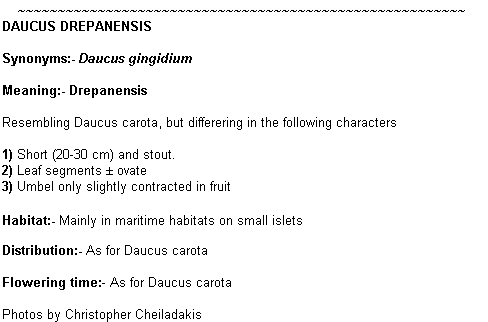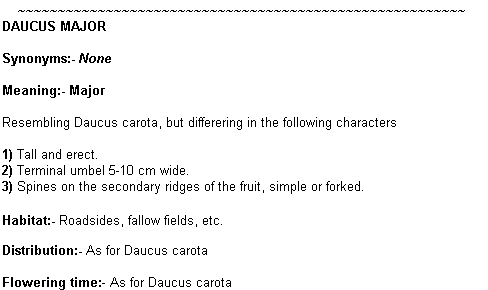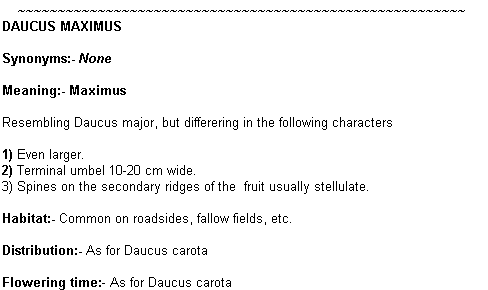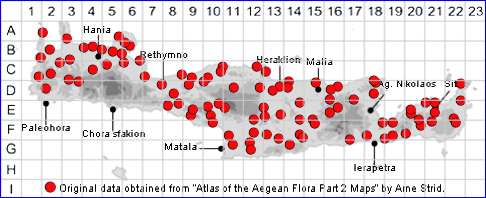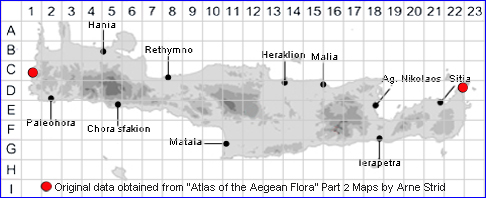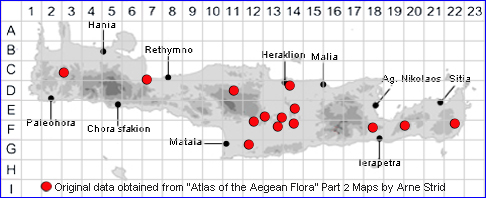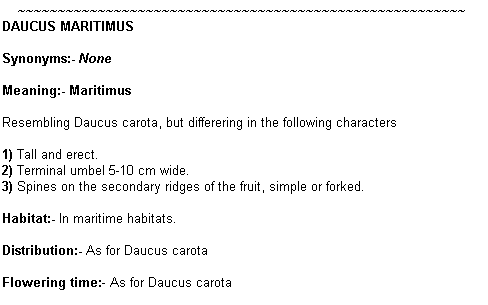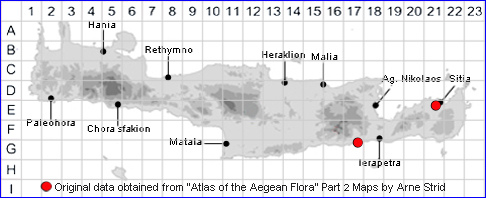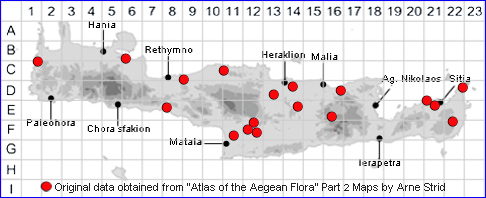SPECIES DESCRIPTION
DAUCUS CAROTA
Including the following subspecies:
Family:- UMBELLIFERAE/Sect. DAUCUS
Common Names:- Wild carrot.
Synonyms:- None
Meaning:- Daucus (L) Latin name for carrot.
Carota (Gr) Old Greek name for carrot.
General description:- Very variable, short to tall, hairy or hairless annual or
biennial.
Stems:-
1) 10-100(-150) cm.
2) Glabrous to hispid.
Leaves:-
1) 2- to 3-pinnate, rarely less divided.
a) segments linear to lanceolate.
b) glabrous to pubescent.
c) thin or fleshy.
2) Upper cauline, often bract-like.
Flowers:-
1) Umbels concave,
a) flat or convex, with a variable number of rays.
2) Bracts as long as the rays or shorter.
a) 1- to 2-pinnatisect.
3) Bracteoles of outer the partial umbels 3-sect.
a) those of the inner simple.
4) Petals white to purplish, often with one or several flowers of the central umbel
dark purple.
Fruit:-
1) 2-4 mm.
2) Spines on the secondary ridges not longer than the width of the mericarps.
Key features:-
1) Lower leaves 2- to 3-pinnate.
a) lobes petiolulate which do not appear to be verticillate.
2) Spines on the secondary ridges of the mericarp simple or 2-pointed.
a) not confluent at the base,
b) not longer than the width of the mericarp.
c) rarely stellulate.
3) Terminal umbels 5-10 cm across.
4) Segments of the lower leaves ovate-lanceolate to lanceolate.
a) dentate or pinnatifid with lanceolate lobes.
Habitat:- Rough grassy habitats, roadsides, hilIslopes, sandy and stony pastures,
cultivated ground, seashores. 0-900(-1400) m.
Distribution:- Common throughout Greece and extremely variable. ~ Widespread in
Europe and SW Asia, introduced else where. Widespread and common on Crete.
Flowering time:- Apr-Aug.
Photos by:- Steve Lenton
FAMILY AND GENUS DESCRIPTIONS
UMBELLIFERAE
General description:- Herbs, rarely shrubs.
Leaves:- Alternate; lamina usually large and much-divided; petiole often inflated
and sheathing at base. Stipules absent.
The primary divisions of the leaves are referred to as segments and the ultimate
divisions, cut nearly or quite to the midrib, as lobes. The lobes may themselves
sometimes be deeply lobed. The leaves are never truly pinnate, but are described
as pinnate, for brevity, when the lamina is divided to the midrib.
Flowers:- Inflorescence usually a compound umbel. Flowers epigynous, small,
hermaphrodite or unisexual, the plant rarely dioecious. Sepals usually small or
absent; petals 5, usually more or less 3-lobed, the middle lobe inflexed; outer
petals sometimes much larger than inner (radiate); stamens 5; carpels (1-)2,
usually attached to a central axis (carpophore), from which the mericarps separate
at maturity; styles (1-)2, often with a thickened base (stylopodium); ovule 1 in each
loculus, pendent.
Descriptions of umbels refer to the terminal, or other well-developed umbel: lateral
umbels are often smaller, with fewer rays, and may be entirely male. Bracts are the
structures which subtend the primary branches (rays) of a compound umbel, and
bracteoles are those which subtend the partial umbel, or the whole of a simple
umbel. When the stylopodium is described, the description refers to the
stylopodium of a hermaphrodite flower.
Fruit:- Dry; pericarp membranous or exocarp variously indurated; endocarp rarely
woody. Mericarps usually joined by a narrow or wide commissure; each mericarp
more or less compressed laterally or dorsally, with 5 longitudinal veins, usually with
ridges over them, separated by valleculae or sometimes with 4 secondary ridges
alternating with the primary; resin canals (vittae) usually present between the
primary ridges and on the commissural face.
Descriptions of the ridges of the fruit refer to the primary ridges, unless otherwise
specified.
Ripe fruit is essential for the certain identification of some genera, though with a
little experience the characters of the ripe fruit can often be deduced from a careful
examination of unripe fruit or even the ovary.
DAUCUS
Leaves:- 2- to 3-pinnate.
Flowers:- Bracts several, usually pinnatisect. Sepals small or obsolete. Petals
white, yellowish or purplish, the outer often radiate; apex inflexed.
Fruit:- Ellipsoid to ovoid, cylindrical or somewhat compressed dorsally; primary
ridges thread-like (filiform), fringed with hairs (ciliate); secondary ridges with a
single row of spines.
Key features:-
1) Both mericarps similar.
2) Fruit with broad, or tubercle-based prickles arranged in 1-3 rows on the ridges.
3) At least some bracts 3-fid or pinnatisect.
Sect. DAUCUS
Leaves:- Leaf-lobes petiolulate.
Flowers:- Umbels pedunculate. Styles medium to long, erecto-patent.
Subsp. drepanensis (Arcang.) Heywood (syn.: D. gin-
gidium auct.): Short (20-30 cm) and stout; leaf segments
:0; ovate; umbel only slightly contracted in fruit. Mainly in
maritime habitats on small islets.
Subsp. major (Vis.) Arcang.: Tall and erect; terminal
umbel 5-10 cm wide; spines on secondary ridges of fruit
simple or forked. Roadsides, fallow ?elds, etc.
Subsp. maritimus (Lam.) Batt.: Short, subglabrous
throughout; terminal umbel 3-5 cm wide. In maritime
habitats.
Subsp. maximus (Desf.) Ball: Like subsp. major, but
even larger; terminal umbel 10-20 cm wide; spines on
secondary ridges of fruit usually stellulate. Common on
roadsides, fallow ?elds, etc.
gidium auct.): Short (20-30 cm) and stout; leaf segments
:0; ovate; umbel only slightly contracted in fruit. Mainly in
maritime habitats on small islets.
Subsp. major (Vis.) Arcang.: Tall and erect; terminal
umbel 5-10 cm wide; spines on secondary ridges of fruit
simple or forked. Roadsides, fallow ?elds, etc.
Subsp. maritimus (Lam.) Batt.: Short, subglabrous
throughout; terminal umbel 3-5 cm wide. In maritime
habitats.
Subsp. maximus (Desf.) Ball: Like subsp. major, but
even larger; terminal umbel 10-20 cm wide; spines on
secondary ridges of fruit usually stellulate. Common on
roadsides, fallow ?elds, etc.
MEDICINAL AND HERBAL USES, MYTHOLOGY AND FOLKLORE
Researched and written by Enda McMullen
the winning entry herself… Ever since, the wild carrot has been known in England as “Queen Anne’s Lace”, a name it carried with it when it was introduced to the Americas by British immigrants.
According to my grandmother “Queen Anne has hairy legs”, which is a reference to the hairy stems of the plant as opposed to the smooth stems of the hemlocks. Another difference regarding the stems is that the stem of the wild carrot is solid, that of the hemlock is hollow. And also on stems, the hemlock stems display at least a dark purple line running down the length of the stem (sometimes it can be completely purple). Wild carrot stems do not display this discolouring.
The flower of the wild carrot has a purple to black “button” in the centre, which is absent in the hemlock flower. The tiny leaves of the wild carrot flower have a tiny pink dot in them, also absent in the hemlock flowers.
When in doubt, another way to find out is to take some leaves of the plant and crush them between your fingers. If it smells like carrot, it is carrot. If it stinks, it’s hemlock and you must wash your hands immediately and thoroughly.
The wild root is edible, however, the root must be pulled when it is young because the high content of Xylem tissue makes it turn woody and inedible very early on in its life. The root is whitish and when crushed smells of carrot.
Once you have the plant properly identified, you have a wonderful source of natural medicine at your disposal. Dioscorides asserts that the best specimen for medicinal use come from Crete.
Wild Carrot tea is an age-old remedy to draw down delayed menstruation. It also helps in combatting difficulties with urination, dropsy and pleurisy. It sooths the digestive tract and stimulates the uterus. Wild carrot anything is therefore off-limits for pregnant women.
The seeds of the wild carrot are the forerunner of today’s morning after pill. Dried seeds were used to make the uterus contract sufficiently to terminate a possible pregnancy immediately. How effective the seeds were is not knows, but studies have confirmed it is well within the possibilities of the seeds having that effect.
An infusion made from fresh leaves (make sure they smell like carrot!) is very effective in cleansing the urinary tract and the kidneys. It is known that it will diminish the size of already formed kidney stones, thereby enabling easier passage. Wild carrot leaves contain significant amounts of porphyrins, which stimulate the pituitary gland and lead to the release of increased levels of sex hormones. This is probably the reason why wild carrot got its reputation as an aphrodisiac.
Crushed leaves, mixed with honey, make a very potent “salve” to sooth and heal infected wounds.
In ancient folklore, it was said that eating the little black button in the centre of the flower cured epilepsy.
Researched and written by Enda McMullen
the winning entry herself… Ever since, the wild carrot has been known in England as “Queen Anne’s Lace”, a name it carried with it when it was introduced to the Americas by British immigrants.
According to my grandmother “Queen Anne has hairy legs”, which is a reference to the hairy stems of the plant as opposed to the smooth stems of the hemlocks. Another difference regarding the stems is that the stem of the wild carrot is solid, that of the hemlock is hollow. And also on stems, the hemlock stems display at least a dark purple line running down the length of the stem (sometimes it can be completely purple). Wild carrot stems do not display this discolouring.
The flower of the wild carrot has a purple to black “button” in the centre, which is absent in the hemlock flower. The tiny leaves of the wild carrot flower have a tiny pink dot in them, also absent in the hemlock flowers.
When in doubt, another way to find out is to take some leaves of the plant and crush them between your fingers. If it smells like carrot, it is carrot. If it stinks, it’s hemlock and you must wash your hands immediately and thoroughly.
The wild root is edible, however, the root must be pulled when it is young because the high content of Xylem tissue makes it turn woody and inedible very early on in its life. The root is whitish and when crushed smells of carrot.
Once you have the plant properly identified, you have a wonderful source of natural medicine at your disposal. Dioscorides asserts that the best specimen for medicinal use come from Crete.
Wild Carrot tea is an age-old remedy to draw down delayed menstruation. It also helps in combatting difficulties with urination, dropsy and pleurisy. It sooths the digestive tract and stimulates the uterus. Wild carrot anything is therefore off-limits for pregnant women.
The seeds of the wild carrot are the forerunner of today’s morning after pill. Dried seeds were used to make the uterus contract sufficiently to terminate a possible pregnancy immediately. How effective the seeds were is not knows, but studies have confirmed it is well within the possibilities of the seeds having that effect.
An infusion made from fresh leaves (make sure they smell like carrot!) is very effective in cleansing the urinary tract and the kidneys. It is known that it will diminish the size of already formed kidney stones, thereby enabling easier passage. Wild carrot leaves contain significant amounts of porphyrins, which stimulate the pituitary gland and lead to the release of increased levels of sex hormones. This is probably the reason why wild carrot got its reputation as an aphrodisiac.
Crushed leaves, mixed with honey, make a very potent “salve” to sooth and heal infected wounds.
In ancient folklore, it was said that eating the little black button in the centre of the flower cured epilepsy.
